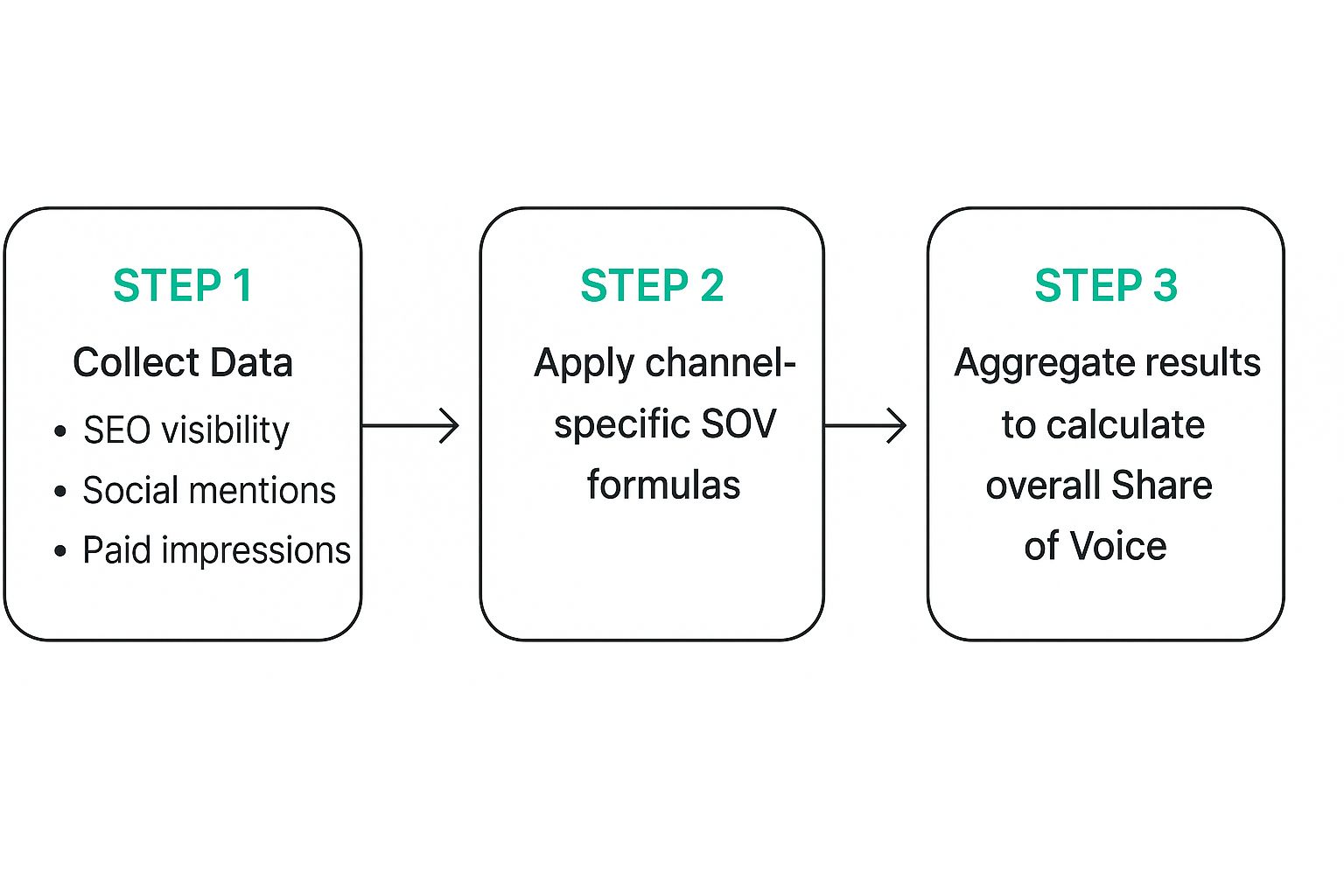How to Calculate Share of Voice for Your Brand
Calculating your Share of Voice (SOV) is actually pretty straightforward. At its core, the formula is simple: divide your brand's metrics by the total market's metrics.
This simple calculation gives you a clear picture of your brand's slice of the conversation. It shows you exactly how visible you are compared to everyone else you're competing with. It doesn't matter if you're tracking social media mentions or search engine impressions—this is your starting point.
What Share of Voice Reveals About Your Brand

Think of Share of Voice as more than just another marketing metric; it's a competitive benchmark that tells you exactly where you stand. Back in the day, it was mainly used to measure the impact of paid ads in newspapers or on TV. Now, its meaning has expanded to cover the entire digital ecosystem, from organic search results to conversations happening on X and Reddit.
Essentially, SOV quantifies your brand's presence. A higher SOV often correlates with greater market share and brand authority, which is a great signal that your marketing efforts are actually connecting with your audience.
The Core Formula in Action
The calculation itself is refreshingly simple. To figure out your Share of Voice, you just divide your brand's online mentions by the total mentions for all brands in your market over the same period.
For example, let's say your brand gets 1,500 social media mentions in a month. If the combined mentions for you and all your competitors total 7,500, your SOV is 20%. This tells you that your brand owns one-fifth of the market conversation, giving you a clear percentage that reflects your share of consumer attention. If you want to dive deeper into how PR metrics feed into this, Prowly has some great resources.
To make it even clearer, here’s a quick breakdown of the core formula.
The Core Share of Voice Formula
| Metric Component | Definition | Example |
|---|---|---|
| Your Brand's Mentions | The total number of times your brand is mentioned across specific channels within a set timeframe. | 1,500 social media mentions in March. |
| Total Market Mentions | The combined number of mentions for your brand plus all your competitors in the same channels and timeframe. | 7,500 total mentions for all competing brands in March. |
| Share of Voice (SOV) | The percentage representing your brand's visibility compared to the total market. | (1,500 / 7,500) * 100 = 20% SOV |
This simple table shows just how easy it is to get a baseline understanding of where you stand.
Key Takeaway: Think of SOV as your brand's volume knob in a crowded room. A high SOV means you're being heard loud and clear over the noise from your competitors.
Understanding this percentage helps you make much smarter strategic decisions. A low SOV might signal that you need to get more aggressive with your marketing, while a high SOV in a specific channel can tell you which of your strategies are hitting the mark.
Tracking this metric consistently allows you to:
- Benchmark against competitors: See exactly how your visibility stacks up against direct rivals and any new players on the scene.
- Identify growth opportunities: If a competitor has a high SOV on a platform you're ignoring, it might be a sign of an untapped channel.
- Measure campaign impact: A sudden spike in SOV right after a product launch or marketing campaign provides tangible proof that it worked.
Setting the Stage for an Accurate Calculation

Before you can even think about calculating your share of voice, you have to lay the groundwork. Jumping straight into data collection without a solid plan is a fast track to getting numbers that don't mean anything.
The accuracy of your final SOV figure hinges entirely on the quality of this initial setup. It’s the classic "garbage in, garbage out" problem. Think of it as defining the boundaries of the playing field before you start keeping score.
Define Your Competitive Landscape
First things first, you need to know exactly who you’re up against. This is about more than just listing your top two or three direct rivals. A truly useful analysis includes a whole mix of players fighting for your audience’s attention.
You should be thinking about a few different categories of competitors:
- Direct Competitors: These are the obvious ones. They offer a similar product or service to the same people you do.
- Indirect Competitors: These guys solve the same problem you do, but with a totally different solution. For instance, a sophisticated project management software is technically competing with a simple spreadsheet template.
- Emerging Threats: Keep your radar on for the new kids on the block. Startups or disruptive companies can gain traction fast and steal market attention before you know it.
By mapping out your full competitive landscape, you ensure your total market mentions metric is realistic. Overlooking a niche but vocal competitor can skew your final SOV percentage, making your brand appear more dominant than it actually is.
Pinpoint the Right Channels and Timeframes
Next, you’ve got to decide which channels actually matter for your business. Are your customers having conversations on LinkedIn and industry forums, or are they all on TikTok and Instagram? Calculating SOV on channels your audience ignores is just a waste of time. Focus your energy where it counts.
The timeframe you choose for your analysis is just as important. A weekly SOV check might be perfect during a big product launch to get real-time feedback. But for tracking long-term brand health, a quarterly analysis makes a lot more sense.
For a deeper dive into the methodologies and nuances of truly getting this right, you can master share of voice calculation with more advanced resources. Getting this prep work right is what makes your data something you can actually use to make smart decisions.
Measuring Your SOV on Key Digital Channels
Alright, let's move from theory to practice. This is where the real work begins. Calculating your share of voice isn’t some one-size-fits-all formula; the metrics and methods you use will change depending on where your audience actually spends their time.
We'll break down how to measure SOV across the digital channels that really matter to your brand.
This graphic gives a great visual overview of how you can pull channel-specific data, use the right formulas, and then bring everything together for a complete SOV picture.

The main thing to remember is that each channel needs its own unique data points. You'll use those for channel-specific calculations before rolling them all up.
Uncovering Your Organic Search SOV
For SEO, share of voice is all about your visibility in search engine results for a specific set of keywords. Instead of just chasing rankings, you’re looking at how many potential impressions your site gets compared to your competitors for those same terms. A big part of this is having a solid process for tracking keyword rankings.
Here’s the basic formula:
- (Your Brand’s Impressions / Total Market Impressions) x 100 = SEO SOV
Imagine you're a SaaS company tracking 50 core industry keywords. Together, those keywords generate 100,000 total impressions a month. If your site shows up for 15,000 of those impressions, your SEO share of voice is 15%.
You can pull this kind of data from tools like Google Search Console or any of the major third-party SEO platforms.
Gauging Your Social Media SOV
On social media, SOV is all about the conversation. You’re tracking how often your brand gets mentioned—either directly with an @mention or just by name—compared to your competitors. Often, you'll want to include specific campaign hashtags in this calculation, too.
This is where social listening tools are absolute game-changers. They automate the heavy lifting of tracking mentions, hashtags, and sentiment, giving you a clear view of who's really owning the discussion.
The formula is pretty simple:
- (Your Brand Mentions / Total Market Mentions) x 100 = Social SOV
Of course, the calculation is only as good as your monitoring. For a deeper look at this, check out our guide on social media reputation monitoring, which gets into the weeds of tracking brand conversations online.
Analyzing Your Paid Media SOV
When you step into the world of paid advertising, like Google Ads or paid social, the most direct way to measure SOV is with a metric called Impression Share. The best part? Ad platforms usually give you this number directly.
Impression Share tells you what percentage of the time your ads were shown out of the total number of times they could have been shown.
If your Impression Share is 40%, that means you're capturing 40% of the available ad space for your target keywords or audience. Your competitors are grabbing the other 60%. It’s a clean, quantifiable way to see how much of the advertising pie you really have.
Finding the Right Tools for the Job

Let's be real: trying to manually track every brand mention, keyword impression, and ad placement is a recipe for disaster. It's just not possible. To get an accurate read on your share of voice, you absolutely need the right software to handle the heavy lifting of data collection and analysis.
But not all tools are created equal. Different platforms are built for different channels, so it’s key to pick the ones that match your specific goals. They generally fall into a few key categories, each playing a unique role in your SOV measurement strategy.
Specialized Platforms for SOV Calculation
Your first stop will likely be a social listening or brand monitoring platform. These tools are designed to scan conversations across social media, forums, and news sites in real time, giving you a constant pulse on what people are saying.
Here’s a breakdown of the essentials:
Social Listening Tools: Think platforms like Sprout Social or Brandwatch. They're perfect for tracking brand mentions, specific hashtags, and what your competitors are up to. They hand you the raw numbers needed for social SOV and often throw in sentiment analysis for good measure.
SEO Visibility Trackers: To really get a grip on your organic search presence, tools like Semrush or Ahrefs are indispensable. They measure keyword visibility and impression share, showing you exactly how much search engine real estate you own compared to your rivals.
Paid Media Analytics: For your paid campaigns, the data is usually baked right into the ad platform itself. In Google Ads, for example, metrics like Impression Share directly tell you your SOV within that specific advertising ecosystem.
When it comes to measuring brand presence, social media is a huge battleground. As the team at Sprout Social points out, SOV is calculated by dividing your brand's metrics by the total market metrics for the same category. Specialized software makes this a breeze by filtering data by network, sentiment, and engagement—giving you much richer insights than just raw numbers.
Many of these platforms are now integrating AI to get even smarter. You can dive into the complete guide to AI lead generation tools to see just how much automation is changing the game.
By combining insights from these different toolsets, you can start to build a truly comprehensive and accurate picture of your brand’s overall share of voice.
A Comparison of Popular Share of Voice Tools
Choosing the right tool depends entirely on where you need to measure your presence. Some are great for social chatter, while others excel at tracking your search engine rankings. This table breaks down the common types of tools to help you decide where to start.
| Tool Category | Example Tools | Primary Use Case | Key SOV Metrics |
|---|---|---|---|
| Social Listening | Sprout Social, Brandwatch | Tracking brand mentions on social media and news | Volume of mentions, reach, sentiment |
| SEO & Content | Semrush, Ahrefs, Moz | Measuring organic search engine visibility | Keyword rankings, impression share, traffic share |
| PPC & Paid Media | Google Ads, Facebook Ads Manager | Analyzing ad campaign visibility on paid channels | Impression Share, click share |
| PR & Media Monitoring | Cision, Muck Rack | Monitoring media coverage and press mentions | Number of articles, media outlet reach |
| Market Research | Statista, Nielsen | Understanding broad market and consumer trends | Brand awareness surveys, market share data |
Ultimately, no single tool does it all. Most brands I've worked with use a combination of these platforms to get a holistic view. A social listening tool paired with an SEO platform is a powerful combo that covers two of the biggest digital marketing channels.
Turning Your SOV Data into Strategic Action
Getting your share of voice number is a great start, but the real magic happens when you actually do something with it. An SOV percentage on its own is just a number. It only becomes a powerful tool when you use it to make smarter marketing decisions.
Think about it. A 15% SOV might be an incredible win for a startup trying to break into a crowded market. But for an established leader, that same number could be a major red flag. Context is everything. The goal isn't just to measure; it's to interpret what you see and then act on it.
Benchmarking and Competitive Analysis
The first thing to do is compare your SOV not just to the industry leader, but also to your closest rivals. If you notice a competitor’s social media SOV is suddenly climbing, it’s time to play detective. Dig into their content and figure out what’s working for them. What are their top-performing posts about? What topics are they hitting, and what tone are they using? You’re looking for clues about what’s resonating with your shared audience.
This analysis gives you a clear roadmap for what to do next. If your organic SOV is lagging, you can zero in on a few key areas to close that gap:
- Targeted Content Creation: Get to work creating blog posts and landing pages that go after the specific keywords where your competitors are outranking you.
- Backlink Building: Launch a campaign focused on earning high-quality links to boost your site's authority where it counts.
- Technical SEO Audits: Make sure your site is fast and user-friendly. These are huge ranking factors you can't afford to ignore.
Your SOV data is basically a playbook handed to you by your competitors. It shows you their strengths, but more importantly, it shines a light on the strategic opportunities where you can challenge them and grab more attention.
When you translate data into specific tactics like these, you stop being a passive observer of your share of voice and start actively shaping it. This strategic response can have a massive impact on your results, turning those insights into real, tangible growth.
And once you’ve captured that attention, you’ll want to convert it. For some actionable next steps on that front, check out our beginner's guide to B2B lead generation.
Common Questions About Share of Voice
Once you start digging into share of voice, a few practical questions almost always pop up. Getting these sorted out early helps you refine your approach and pull more value from the data you're collecting. Let's tackle a few of the most common ones I hear.
How Often Should I Calculate My Share of Voice?
There's no magic number here; it really depends on your industry and what you’re trying to achieve. If you're a fast-moving consumer brand in the middle of a big product launch, you might want to check in weekly or even daily to see the immediate splash you're making.
For most B2B companies or brands in slower-paced sectors, a monthly or quarterly look is usually the sweet spot. This cadence is frequent enough to spot real trends without getting bogged down in the daily noise. It gives you a stable, strategic view of how your campaigns are shifting your market presence over time.
Is a High Share of Voice Always a Good Thing?
Not at all. A high SOV means you’re dominating the conversation, but it doesn't tell you why. If your brand is all over the news because of a PR nightmare or a flood of negative reviews, that high share of voice is actually a major red flag.
This is exactly why you need to pair SOV with sentiment analysis. A 25% SOV with 90% positive sentiment is way more valuable than a 50% SOV that’s fueled by customer complaints. Context is everything.
Can I Calculate SOV on a Tight Budget?
Absolutely. You don't need expensive enterprise-level tools to get a solid directional sense of your SOV. Plenty of small businesses and even solopreneurs can track their presence effectively with more accessible methods. It just takes a bit more hands-on effort.
Consider these budget-friendly options to get started:
- Google Alerts: Set up free alerts for your brand name and your top competitors. It’s a simple way to monitor mentions across the web.
- Manual Social Searches: Use the built-in search functions on platforms like X and LinkedIn. You can manually count mentions of your brand versus your competitors to get a rough idea.
- Free SEO Tools: The free versions of popular SEO tools or even Google Search Console can help you track keyword impressions for a core set of terms.
It’s definitely more labor-intensive, but these methods give you a foundational understanding of where you stand in the conversation.
Ready to stop guessing and start listening? Intently uses AI to monitor conversations on Reddit, X, and LinkedIn, delivering high-intent leads directly to you. See how it works.
